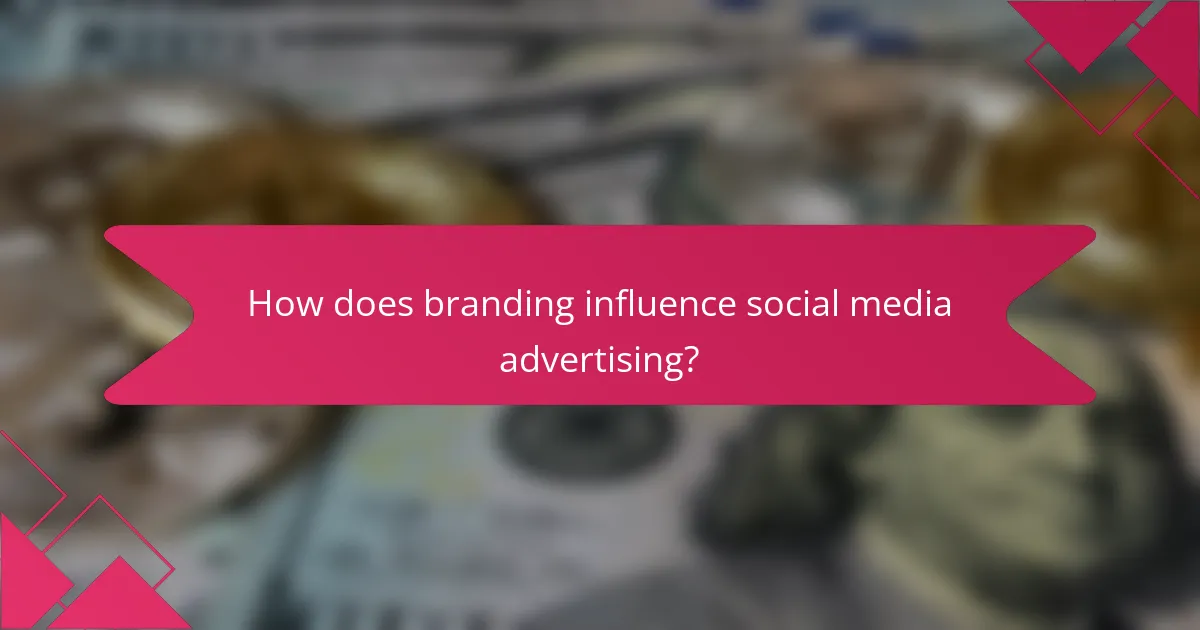In the competitive landscape of social media advertising, effective visual design plays a crucial role in capturing attention and conveying messages swiftly. By employing impactful techniques and a strong branding strategy, businesses can significantly enhance engagement and conversion rates, ultimately fostering brand loyalty and recognition.

How can effective visual design enhance social media ads?
Effective visual design significantly boosts the impact of social media ads by capturing attention and conveying messages quickly. A well-designed ad can improve engagement rates and brand recognition, leading to higher conversion rates.
Use of color psychology
Color psychology plays a crucial role in visual design by influencing emotions and perceptions. For instance, blue often conveys trust, while red can evoke urgency. Selecting the right color palette can enhance brand identity and encourage desired actions.
When designing ads, consider using contrasting colors to make key elements stand out. A/B testing different color schemes can help determine which combinations resonate best with your target audience.
Importance of typography
Typography affects readability and brand perception in social media ads. Choosing the right font can enhance the message’s clarity and tone, whether it’s playful, serious, or professional. Stick to two or three complementary fonts to maintain visual harmony.
Ensure that text is legible across devices by using appropriate sizes and weights. Avoid overly decorative fonts that may confuse viewers or detract from the message.
Incorporating brand elements
Integrating brand elements, such as logos and consistent color schemes, reinforces brand identity in social media ads. This consistency helps build recognition and trust among consumers. Ensure that these elements are prominent but not overpowering.
Utilize brand guidelines to maintain a cohesive look across all ads. This approach not only strengthens brand recall but also fosters a professional image.
Creating eye-catching visuals
Eye-catching visuals are essential for grabbing attention in crowded social media feeds. Use high-quality images, bold graphics, and dynamic layouts to create ads that stand out. Incorporate elements like patterns or textures to add depth.
Consider using white space effectively to avoid clutter and draw focus to key messages or calls to action. Simple yet striking designs often yield better engagement than overly complex ones.
Utilizing video content
Video content can significantly enhance social media ads by providing dynamic storytelling opportunities. Short videos, ideally under 30 seconds, can convey messages quickly and effectively, leading to higher engagement rates compared to static images.
Incorporate captions to ensure your message is understood even without sound, as many users scroll through feeds with muted audio. Experiment with different formats, such as live videos or animations, to see what resonates best with your audience.

What impact techniques improve ad performance?
Effective impact techniques can significantly enhance ad performance by increasing engagement and conversion rates. Key strategies include understanding your target audience, utilizing user-generated content, conducting A/B testing, and implementing retargeting strategies.
Target audience segmentation
Target audience segmentation involves dividing your audience into distinct groups based on demographics, interests, or behaviors. This allows for tailored messaging that resonates more deeply with each segment, leading to higher engagement rates.
To effectively segment your audience, consider using tools like analytics platforms to gather data on user behavior. For example, you might create segments based on age, location, or purchasing habits, enabling you to craft specific ads that appeal to each group.
Leveraging user-generated content
User-generated content (UGC) refers to any content created by your customers, such as reviews, photos, or videos. Incorporating UGC into your ads can build trust and authenticity, as potential customers often relate more to real users than to brand messages.
Encourage your audience to share their experiences with your products on social media. You can then feature this content in your ads, which not only showcases your product in a relatable way but also fosters community engagement.
Implementing A/B testing
A/B testing, or split testing, involves comparing two versions of an ad to determine which performs better. By systematically testing different elements, such as headlines, images, or calls to action, you can optimize your ads for maximum effectiveness.
Start by changing one variable at a time and track performance metrics like click-through rates and conversions. This method allows you to make data-driven decisions that enhance your advertising strategy over time.
Utilizing retargeting strategies
Retargeting strategies focus on reaching users who have previously interacted with your brand but did not convert. By showing ads to these users, you can remind them of your products and encourage them to complete their purchase.
Implement retargeting through platforms like Google Ads or Facebook Ads, which allow you to create custom audiences based on past interactions. This approach can lead to higher conversion rates, as these users are already familiar with your brand.

How does branding influence social media advertising?
Branding significantly impacts social media advertising by shaping how audiences perceive and engage with a brand. A strong brand identity can enhance recognition, foster loyalty, and drive conversions across various platforms.
Consistency across platforms
Maintaining consistency in branding across social media platforms is crucial for building recognition. This includes using the same logos, color schemes, and messaging styles, which help create a cohesive brand image. For example, a brand that uses a specific shade of blue on Instagram should also use that same shade on Facebook and Twitter.
Inconsistencies can confuse potential customers and dilute brand identity. Aim for uniformity in visual elements and tone, ensuring that your audience has a seamless experience regardless of where they encounter your brand.
Building brand trust
Branding plays a vital role in establishing trust with your audience. When consumers see consistent branding and messaging, they are more likely to view the brand as reliable and credible. This trust can lead to higher engagement rates and increased customer loyalty.
To build trust, ensure that your branding reflects your values and mission. Transparency in your advertising, such as clearly stating product benefits and pricing, can further enhance trustworthiness. Regularly interacting with your audience through comments and messages also reinforces a trustworthy image.
Creating a unique brand voice
A unique brand voice differentiates your business from competitors and resonates with your target audience. This voice should reflect your brand’s personality, whether it’s professional, casual, humorous, or authoritative. For instance, a playful brand may use light-hearted language and emojis, while a luxury brand may adopt a more formal tone.
To develop your brand voice, consider your audience’s preferences and the emotions you want to evoke. Consistently applying this voice in your social media ads helps to create a memorable brand experience, encouraging deeper connections with your audience.

What are the best practices for social media ad design?
The best practices for social media ad design focus on creating visually appealing, engaging, and effective ads that resonate with your target audience. Key elements include selecting the right ad format, optimizing for mobile devices, and incorporating a clear call-to-action.
Ad format selection
Selecting the appropriate ad format is crucial for maximizing engagement and effectiveness. Common formats include image ads, video ads, carousel ads, and stories, each serving different marketing objectives. For instance, video ads tend to capture attention quickly, while carousel ads allow for showcasing multiple products or features.
Consider the platform’s strengths when choosing an ad format. For example, Instagram favors visually striking images and videos, while LinkedIn is more suited for professional content. Tailoring your format to the platform can enhance user interaction and conversion rates.
Mobile optimization
With a significant portion of social media traffic coming from mobile devices, optimizing ads for mobile is essential. Ensure that your visuals are clear and legible on smaller screens, using bold text and high-contrast colors to enhance visibility. Additionally, consider the loading speed of your ads, as slow-loading content can lead to high bounce rates.
Responsive design is key; test how your ads appear on various devices and orientations. Aim for a seamless experience that encourages users to engage with your content without frustration. This can significantly improve your ad performance and ROI.
Clear call-to-action
A clear call-to-action (CTA) guides users on what to do next, making it a vital component of effective social media ads. Use concise and compelling language that prompts immediate action, such as “Shop Now,” “Learn More,” or “Sign Up Today.” Position your CTA prominently within the ad to ensure it captures attention.
Experiment with different CTAs to see which resonates best with your audience. A/B testing can help identify the most effective wording and placement. Avoid vague phrases; instead, be direct about the benefits users will gain by following through with the action.

What criteria should businesses consider when choosing social media platforms?
Businesses should evaluate social media platforms based on their target audience, ad format compatibility, and overall marketing goals. Selecting the right platform can significantly enhance engagement and return on investment.
Demographics of target audience
Understanding the demographics of your target audience is crucial when selecting a social media platform. Different platforms attract varying age groups, genders, and interests. For instance, platforms like Instagram and TikTok are popular among younger users, while Facebook tends to have a broader age range.
Consider conducting market research to identify where your audience spends their time online. This can help you focus your advertising efforts on platforms that align with your target demographics, maximizing your reach and effectiveness.
Ad format compatibility
Each social media platform offers different ad formats, such as image ads, video ads, or carousel ads. It’s essential to choose a platform that supports the ad formats that best showcase your products or services. For example, visually-driven brands may benefit from platforms like Instagram, which emphasizes high-quality images and videos.
Before committing to a platform, review the available ad formats and consider how they align with your marketing strategy. Testing various formats can also provide insights into what resonates most with your audience, allowing for more effective campaigns.










